Quadrilateral Worksheets geometry Class 9 Maths have been designed as per the latest pattern for CBSE, NCERT and KVS for Grade 9. Students are always suggested to solve printable worksheets for Mathematics Quadrilaterals Grade 9 as they can be really helpful to clear their concepts and improve problem solving skills. We at worksheetsbag.com have provided here free PDF worksheets for students in standard 9 so that you can easily take print of these test sheets and use them daily for practice. All worksheets are easy to download and have been designed by teachers of Class 9 for benefit of students and is available for free download.
Mathematics Quadrilaterals Worksheets for Class 9
We have provided chapter-wise worksheets for class 9 Mathematics Quadrilaterals which the students can download in Pdf format for free. This is the best collection of Mathematics Quadrilaterals standard 9th worksheets with important questions and answers for each grade 9th Mathematics Quadrilaterals chapter so that the students are able to properly practice and gain more marks in Class 9 Mathematics Quadrilaterals class tests and exams.
Chapter-wise Class 9 Mathematics Quadrilaterals Worksheets Pdf Download
• Angle Sum Property of a Quadrilateral
• Types of Quadrilaterals
• Properties of a Parallelogram
• The Mid-Point Theorem
(1) Sum of the angles of a quadrilateral is 360o
(2) A diagonals of a parallelogram divides it into two congruent triangles.
(3) In a parallelogram
(a) diagonals bisect each other.
(b) opposite angles are equal.
(c) opposite sides are equal
(4) Diagonals of a square bisects each other at right angles and are equal, and vice-versa.
(5) A line through the mid-point of a side of a triangle parallel to another side bisects the third side. (mid-point theorem)
(6) The line through the mid points of sides of a Δ || to third side and half of it.
(7) A quadrilateral is a parallelogram, if
(a) its opposite angles are equal.
(b) its opposite sides are equal.
(c) its diagonals bisect each other.
(d) a pair of opposite sides is equal and parallel.
(8) Diagonals of a rectangle bisect each other and are equal and vice-versa.
(9) Diagonals of a rhombus bisect each other at right angles and vice-versa.
(10) A line through the mid-point of a side of a triangle parallel to another side bisects the third side.
(11) The line-segment joining the mid-points of any two sides of a triangle is parallel to the third side and is half of it.
Question. Three angles of a quadrilateral are 75º, 90º and 75º. The fourth angle is
(A) 90º
(B) 95º
(C) 105º
(D) 120º
Answer
D
Question. A diagonal of a rectangle is inclined to one side of the rectangle at 25º. The acute angle between the diagonals is
(A) 55º
(B) 50º
(C) 40º
(D) 25º
Answer
B
Question. The quadrilateral formed by joining the mid-points of the sides of a quadrilateral PQRS, taken in order, is a rectangle, if
(A) PQRS is a rectangle
(B) PQRS is a parallelogram
(C) diagonals of PQRS are perpendicular
(D) diagonals of PQRS are equal.
Answer
C
Question. If APB and CQD are two parallel lines, then the bisectors of the angles APQ, BPQ, CQP and PQD form
(A) a square
(B) a rhombus
(C) a rectangle
(D) any other parallelogram
Answer
C
Question. If angles A, B, C and D of the quadrilateral ABCD, taken in order, are in the ratio 3:7:6:4, then ABCD is a
(A) rhombus
(B) parallelogram
(C) trapezium
(D) kite
Answer
C
Question. ABCD is a rhombus such that ∠ACB = 40º. Then ∠ADB is
(A) 40º
(B) 45º
(C) 50º
(D) 60º
Answer
C
Question. D and E are the mid-points of the sides AB and AC of ΔABC and O is any point on side BC. O is joined to A. If P and Q are the mid-points of OB and OC respectively, then DEQP is
(A) a square
(B) a rectangle
(C) a rhombus
(D) a parallelogram
Answer
D
Question. If bisectors of ∠A and ∠B of a quadrilateral ABCD intersect each other at P, of ∠B and ∠C at Q, of ∠C and ∠D at R and of ∠D and ∠A at S, then PQRS is a
(A) rectangle
(B) rhombus
(C) parallelogram
(D) quadrilateral whose opposite angles are supplementary
Answer
D
Question. Which of the following is not true for a parallelogram?
(A) opposite sides are equal
(B) opposite angles are equal
(C) opposite angles are bisected by the diagonals
(D) diagonals bisect each other.
Answer
C
Question. The figure obtained by joining the mid-points of the sides of a rhombus, taken in order, is
(A) a rhombus
(B) a rectangle
(C) a square
(D) any parallelogram
Answer
B
Question. The diagonals AC and BD of a parallelogram ABCD intersect each other at the point O. If ∠DAC = 32º and ∠AOB = 70º, then ∠DBC is equal to
(A) 24º
(B) 86º
(C) 38º
(D) 32º
Answer
C
Question. The figure formed by joining the mid-points of the sides of a quadrilateral ABCD, taken in order, is a square only if,
(A) ABCD is a rhombus
(B) diagonals of ABCD are equal
(C) diagonals of ABCD are equal and perpendicular
(D) diagonals of ABCD are perpendicular
Answer
C
Question. D and E are the mid-points of the sides AB and AC respectively of Δ ABC. DE is produced to F. To prove that CF is equal and parallel to DA, we need an additional information which is
(A) ∠DAE = ∠EFC
(B) AE = EF
(C) DE = EF
(D) ∠ADE = ∠ECF.
Answer
C
Question. Diagonals of a rectangle are equal and perpendicular. Is this statement true? Give reason for your answer.
Sol. The given statement is not true. Diagonals of a rectangle need not to be perpendicular.
Question. Diagonals of a parallelogram are perpendicular to each other. Is this statement true? Give reason for your answer.
Sol. This statement not true. Diagonals of a parallelogram bisect each other.
Question. In Fig.8.1, it is given that BDEF and FDCE are parallelograms. Can you say that BD = CD? Why or why not?

Sol. BDEF is a parallelogram.
∴ BD = EF …(1)
[Opposite side of a parallelogram]
FDCE is a parallelogram
∴ CD = EF …(2)
From (1) and (2), we get
BD = CD
Question. In quadrilateral ABCD, ∠A + ∠D = 180º. What special name can be given to this quadrilateral?
Sol. In quadrilateral ABCD, ∠A + ∠D = 180º i.e., the sum of two consecutive angles is 180º. So, pair of opposite side AB and CD are parallel. Therefore, quadrilateral ABCD is trapezium. Hence, special name which can be given to this quadrilateral ABCD is trapezium.
Question. Can all the angles of a quadrilateral be acute angles? Give reason for your answer.
Sol. We know that an acute angle is less than 90º. All the angles of a quadrilateral cannot be acute angles because than equal sum of a quadrilateral will be than a 360º, whereas angle sum of quadrilateral is 360o.
Question. All the angles of a quadrilateral are equal. What special name is given to this quadrilateral?
Sol. All the angle of a quadrilateral are equal. Also, the sum of angles of a quadrilateral is 360º. Therefore, each angle of quadrilateral is 90o. So, the given quadrilateral is a rectangle.
Hence, special name given quadrilateral is rectangle.
Question. Can the angles 110º, 80º, 70º and 95º be the angles of a quadrilateral? Why or why not?
Sol. Sum of these angles 110º + 80º + 70º + 95º = 355º But, sum of the angles of a quadrilateral is always 360o. Hence, 110º, 80º, 70º and 95º cannot be the angles of a quadrilateral.
Question. One angle of a quadrilateral is of 108º and the remaining three angles are equal. Find each of the three equal angles.
Sol. One angle of a quadrilateral is of 180º and let each of the three remaining equal angles be xº.
As the sum of the angles of a quadrilateral is 360º.
∴ 180º + x + x + x = 360º ⇒ 3x = 360º − 180º = 252º
∴ x = 252º ÷ 3 = 84º
Hence, each of the three angles be 84º.
Question. In ΔABC, AB = 5 cm, BC = 8 cm and CA = 7 cm. If D and E are respectively the midpoints of AB an BC, determine the length of DE.
Sol. In Δ ABC, AB = 5 cm, BC = 8 cm and CA= 7 cm. D and E are respectively the mid-points of AB and BC.

[Using the mid-point theorem]
Question. Diagonals AC and BD of a parallelogram ABCD intersect each other at O. If OA = 3 cm and OD = 2 cm, determine the lengths of AC and BD.
Sol. We know that diagonals of a parallelogram bisect each other.
∴ AC = 2 × OA = 2 × 3 cm = 6 cm
And BD = 2OD = 2 × 2 cm = 4 cm
Hence, lengths of AC and BD are 6 cm and 4 cm respectively.
10. In Fig.8.2, ABCD and AEFG are two parallelograms. If ∠C = 55º, determine ∠F.

Sol. We know that opposite angle of parallelogram are equal.
In parallelogram ABCD, we have
∠A = ∠C
But, ∠C = 55º [Given]
∠A = 55º
Now, in parallelogram AEFG, we have
∠F = ∠A = 55º
Hence, ∠F = 55º .
Question. Opposite angles of a quadrilateral ABCD are equal. If AB = 4 cm, determine CD.
Sol. Since opposite angles of a quadrilateral ACBD are equal. If AB = cm, determine CD.
[ ∵ Opposite sides of a parallelogram are equal]
But, AB = 4cm, therefore CD = 4cm.
Hence, CD = 4cm.
Question. Can all the angles of a quadrilateral be right angles? Give reason for your answer.
Sol. Yes, all the angles of a quadrilateral can be right angles. Angles sum of a quadrilateral will be 360o, which is true.
Question. Diagonals of a quadrilateral ABCD bisect each other. If ∠A= 35º, determine ∠B.
Sol. As the diagonals of a quadrilateral ABCD bisect each other, so ABCD is a parallelogram. Now, ABCD is a parallelogram
∴ ∠A+∠B =1800
[∵Adjacent angles of a parallelogram are supplementary]
∴ 35 +∠B =18º
⇒ ∠B =180º −35º =145º
Question. E is the mid-point of the side AD of the trapezium ABCD with AB||DC. A line through E drawn parallel to AB intersect BC at F . Show that F is the mid-point of BC. [Hint: Join AC]
Sol. Given: A trapezium ABCD in which AB||CD and E is mid-point of the side AB. Also, EF||AB.
To prove: F is the mid-point of BC.

Construction: Join AC which intersect EF at O.
Proof: In ΔADC, E is the mid-point of AD and EF||DC.
[∵ EF||AB and DC||AB ⇒AB||EF||DC]
∴ O is the mid-point of AC. [Converse of mid – point theorem]
Now, in ΔCAB,O is the mid-point of AC and OF||AB.
⇒ OF bisects BC.
Or F is the mid-point of BC.
Hence, proved.
Question. ABCD is a trapezium in which AB || DC and ∠A = ∠B = 45º. Find angles C and D of the trapezium.
Sol. ABCD is a trapezium in which AB||DC.

Now, AB||DC and AD is transversal.
∴ ∠A+∠D =180º
[∵ Sum of interior angles on the side of the transversal is 180º]
⇒ 45º + ∠D =180º
⇒ ∠D = 180º − 45 = 135º
Similarly, 0 ∠B +∠C =180º
⇒ 45º + ∠C =180º
⇒ ∠C = 180º − 45º = 135º
Hence, ∠A = ∠B = 45º and 0 ∠C = ∠D = 135º .
Question. The angle between two altitudes of a parallelogram through the vertex of an obtuse angle of the parallelogram is 60º. Find the angles of the parallelogram.
Sol. In quadrilateral PBQD,

∠1 + ∠2 + ∠B + ∠3 = 360º
⇒60º + 90º +∠B + 90º = 360º
⇒ ∠B + 240º = 360º
⇒ ∠B = 360º − 240º
⇒ ∠B =120º
Now, ∠ADC = ∠B =120º
[∵Opposite angles of a parallelogram are equal]
∠A+∠B =180º
[∵Sum of consecutive interior angles is 180o]
⇒ ∠A + 120º = 180º
⇒ ∠A =180º − 120º
⇒ ∠A = 60º
But, ∠C = ∠A = 60º
[∵Opposite angles of a parallelogram are equal]
Question. E and F are points on diagonal AC of a parallelogram ABCD such that AE = CF. Show that BFDE is a parallelogram.
Sol. Given: A parallelogram ABCD: E and F are points of diagonal AC of parallelogram ABCD such that AE = CF.
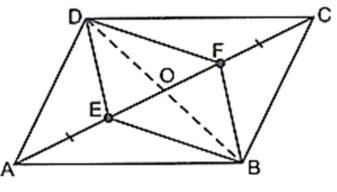
To prove: BFDE is parallelogram.
Proof: ABCD is s parallelogram.
∴ OD = OB …(1) [ ∵Diagonals of parallelogram bisect each other]
OA = OC …(2) [Same reason as above]
AE = CF …(3) [Given]
Subtracting (3) from (2), we get
OA – AE = OC – CF
⇒ OE = OF …(4)
∴ BFDE is parallelogram. [∵OD = OB and OE = OF]
Hence, proved.
Question. Through A, B and C, lines RQ, PR and QP have been drawn, respectively parallel to sides BC, CA and AB of a Δ ABC as shown in Fig.8.5. Show that BC = 1/2 QR
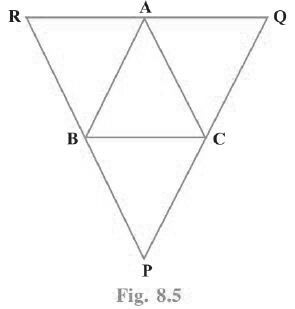
Sol. Given: Triangle ABC and PQR in which AB||PQ, BC||RQ and CA||PR.
To prove: BC = 1/2 QR
Proof: Quadrilateral RBCA is a parallelogram.
[∵ RA||BC and BR||CA]
∴ RA = BC …(1) [∵Opposite side of parallelogram]
Now, quadrilateral BCQA is a parallelogram.
∴ AQ = BC …(2) [∵Opposite side of parallelogram]
Adding (1) and (2), we get
RA + AQ = 2BC
⇒ QR = 2BC
⇒ BC = 1/2 QR
Hence, proved.
Question. Can all the four angles of a quadrilateral be obtuse angles? Give reason for your answer.
Sol. No, because then the sum of four angles of the quadrilateral will be more than 360º whereas sum of four angles of a quadrilateral is always equal to 360º.
Question. ABCD is a rhombus in which altitude from D to side AB bisects AB. Find the angles of the rhombus.
Sol. In DAPD and DBPD, we have
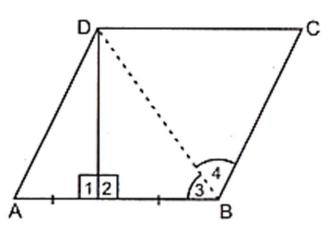
AP = BP [Given]
∠1 = ∠2 [∵Each equal to 90º]
PD = PD [Common side]
So, by SAS Criterion of congruence, we have
ΔAPD ≅ ΔBPD
∴ ∠A = ∠3 [CPCT]
But, ∠3 = ∠4 [∵ Diagonals bisect opposite angles of a rhombus]
⇒ ∠A = ∠3 = ∠4 …(1)
Now, AD||BC
SO, 0 ∠A+∠ABC =180º [∵Sum of consecutive interior angles is 180º]
⇒ ∠A+ ∠3+∠4 =180º
⇒ ∠A+ ∠A+∠A =18º0 [Using (1)]
3∠A =180º
⇒ ∠A =180º/3 = 60º
Now, ∠ABC = ∠3 + ∠4
= 60º + 60º
=1200 [∵ Opposite angles of a rhombus are equal]
∴ ∠ADC = ∠ABC =120º [Same reason as above]
Question. D, E and F are the mid-points of the sides BC, CA and AB, respectively of an equilateral triangle ABC. Show that ΔDEF is also an equilateral triangle.
Sol. Given: ΔABC is an equilateral triangle. D, E and F are the mid-points of the sides BC, CA and AB, respectively of ΔABC.

To prove: ΔDEF is an equilateral triangle.
Proof: EF joints mid-points of sides of AB and AC respectively.
∴ EF = 1/2 BC …(1) [Mid-point theorem]
Similarly ,DE = 1/2 BC …(2) [Mid-point theorem]
DF = 1/2 AC …(3) [Mid-point theorem]
But, AB = BC = CA …(4) [Sides of an equilateral ΔABC]
From (1), (2), (3) and (4), we have
DE = EF = FD
∴ ΔDEF is an equilateral triangle.
Hence, proved.
Question. Points P and Q have been taken on opposite sides AB and CD, respectively of a parallelogram ABCD such that AP= CQ (Fig. 8.6). Show that AC and PQ bisect each other.
Sol. Points P and Q have been taken on opposite sides AB and CD respectively of a parallelogram ABCD such that AP = CQ.

In ΔAOP and ΔCOQ, we have
AP = CQ [Given]
∠1 = ∠2 [Alt. int. ∠s are equal]
∠3 = ∠4 [Vertically opp. ∠s ]
∴ ΔAOP ≅ ΔCOQ [By SAS congruence rule]
∴ OA = OC and OP = OQ [CPCT]
Hence, AC and PQ bisect each other.
Question. In Fig. 8.7, P is the mid-point of side BC of a parallelogram ABCD such that ∠BAP = ∠DAP. Prove that AD = 2CD.
Sol. ∠BAP = ∠DAP = 1/2 ∠A …(1)
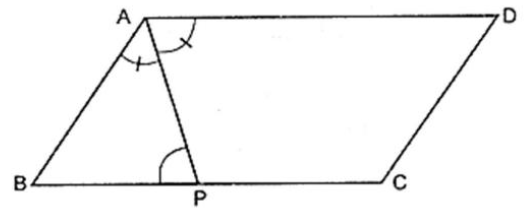
Since ABCD is a parallelogram, we have
∠A + ∠B = 180º …(2)
[∵ Sum of interior angles on the same sides of transversal is 180º]
In ΔABP, we have
∠BAP + ∠B + ∠APB = 180º
⇒ 1/2 θ∠A = 180º −∠A + ∠APB = 180º [Using (1) and (2)]
⇒ ∠APB = 1/2 ∠A …(3)
From (1) and (3), we get
∠BAP = ∠APB
BP = AB …(4)
[∵ Side of opposite to equal angles are equal]
Since opposite sides of a parallelogram are equal, we have
AD = BC ⇒ 1/2 AD = 1/2 BC
⇒ 1/2 AD = BP [∵P is the mid-point of BC]
⇒ 1/2 AD = AB [∵From (4), BP = AB]
Since, opposite sides of a parallelogram are equal, we have
1/2 AD = CD ⇒ AD = CD
Hence, proved.
Question. A square is inscribed in an isosceles right triangle so that the square and the triangle have one angle common. Show that the vertex of the square opposite the vertex of the common angle bisects the hypotenuse.
Sol. ABC is an isosceles right triangle with AB = BC. A square BFED is inscribed in triangle ABC so that ∠B = common = 90o. In ΔADE and ΔEFC, we have
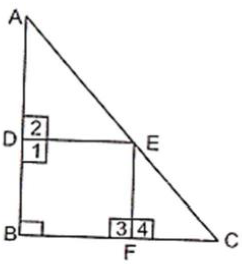
DE = EF …(1) [∵Sides of a square are equal]
∠1+∠2 =180º [Linear pair axiom]
⇒ 90º +∠2 =180º [∵Each angle of a square = 90º]
⇒ ∠2 = 90
Similarly, ∠4 = 90º
∴ ∠2 = ∠4 …(2) [∵Each = 90o]
Now, AB = BC [Given]
∴ ∠C = ∠A …(3) [∵Angles opp. To equal sides are equal]
From (1), (2) and (3), we get
ΔADE ≅ ΔEFC [By AAS Congruence rule]
Hence, AE = EC [CPCT]
Question. In a parallelogram ABCD, AB = 10 cm and AD = 6 cm. The bisector of ∠A meets DC in E. AE and BC produced meet at F. Find the length of CF
Sol. ABCD is a parallelogram, in which AB = 10cm and AD = 6cm. The bisector of ∠A meets DC in E. AE and BC produced meet at F.
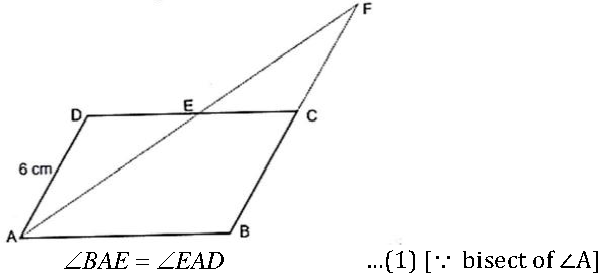
∠EAD = ∠EFB …(2) [ Alt. ∠s ]
⇒ ∠BAE = ∠EFB [From (1) and (2)]
∴ BF = AB [∵Sides opposite to equal ∠s are equal]
⇒ BF = 10 cm [∵ AB = 10 cm]
⇒ BC + CF = 10 cm ⇒ 6 cm + CF = 10 cm
[∵ BC = AD = 6 cm, opposite sides of a ||gm]
⇒ CF = 10 – 6 cm = 4 cm
Question. P, Q, R and S are respectively the mid-points of the sides AB, BC, CD and DA of a quadrilateral ABCD in which AC = BD. Prove that PQRS is a rhombus.
Sol. Given: A quadrilateral ABCD in which AC = BD and P, Q, R and S are respectively the midpoint of the sides of AB, BC, CD and DA of quadrilateral ABCD.

To prove: PQRS is a rhombus.
Proof: In DABC, P and Q are the mid-points of AB and BC respectively.
That is, PQ joins mid-points of sides AB and BC.
∴ PQ || AC …(1)
And PQ = (1/2) AC …(2) [Mid-point theorem]
In ΔADC, R and S are the mid-points of CD and AD respectively.
∴ SR || AC …(3)
And SR = (1/2)AC …(4) [Mid-point theorem]
From (1) and (3), we get
PQ||SR
From (2) and (4), we get
PQ = RS
⇒ PQRS is a parallelogram.
In ΔDAB, SP joins mid-points of sides of DA and AB respectively.
∴ SP = (1/2) BD …(5) [Mid-point theorem]
AC = BD …(6) [Given]
From equations (2), (5) and (6), we get
SP = PQ
∴ Parallelogram PQRS is a rhombus.
Hence, proved.
Question. P, Q, R and S are respectively the mid-points of the sides AB, BC, CD and DA of a quadrilateral ABCD such that AC ⊥BD. Prove that PQRS is a rectangle.
Sol. Given: A quadrilateral ABCD in which AC ⊥ BD and P, Q, R and S are respectively the mid-points of the sides AB, BC CD and DA of quadrilateral ABCD.

To Prove: In ΔABC, P and Q are the mid-point od sides AB and BC respectively.
That is, PQ joins mid-points of sides AB and BC.
∴ PQ|| AC …(1)
And PQ = (1/2) AC …(2) [Mid-point theorem]
In ΔADC, R and S are the mid-points of CD and AD respectively.
∴ SR || AC …(3)
And SR = (1/2) AC …(4) [Mid-point theorem]
From (1) and (3), we get
PQ||SR
From (2) and (4), we get
PQ = RS
⇒ PQRS is a parallelogram.
PQ||AC [Proved above]
⇒ PG||GF
In ΔABD, PS joins mid-points of sides AB and AD respectively.
∴ PS||MD [Mid-point theorem]
⇒ PG||EF
⇒ PEFG is a parallelogram [∵ PE||GF and PG||EF]
⇒ ∠1 = ∠2 [∵ Opposite angles of a parallelogram are equal]
But, ∠1= 90º [∵AC ⊥ BD]
∴ ∠2 = 90º
⇒ Parallelogram PQRS is a rectangle.
Question. P, Q, R and S are respectively the mid-points of sides AB, BC, CD and DA of quadrilateral ABCD in which AC = BD and AC⊥BD. Prove that PQRS is a square.
Sol. Given: A quadrilateral ABCD is which AC = BD and AC⊥BD. P, Q, R and S respectively the mid-points of sides AB, BC, CD and DA of quadrilateral ABCD.
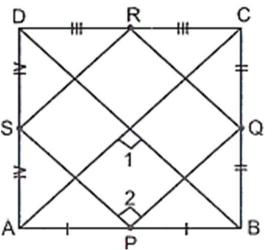
To prove: PQRS is a square.
Proof: Parallelogram PQRS is a rectangle.

AC = BD …(3) [Given]
From (1), (2) and (3), we get
PS = PQ
⇒ Rectangle PQRS is a square.
Question. A diagonal of a parallelogram bisects one of its angles. Show that it is a rhombus.
Sol. ABCD is a parallelogram and diagonal AC bisect ÐA. We have to show that ABCD is a rhombus.

∠1 = ∠2 …(1) [∵AC bisect ∠A ]
∠2 = ∠4 …(2) [Alt. interior angles]
From (1) and (2), we get
∠1 = ∠4
Now, in DABC, we have
∠1 = ∠4 [Proved above]
∴ BC = AB [∵Side. Opp. To equal ∠s are equal]
Also, AB = DC and AD = BC [∵Opposite sides of a parallelogram are equal]
So, ABCD is a parallelogram in which its sides AB = BC = CD = AD.
Hence, ABCD is a rhombus.
Question. P and Q are the mid-points of the opposite sides AB and CD of a parallelogram ABCD. AQ intersects DP at S and BQ intersects CP at R. Show that PRQS is a parallelogram.
Sol. Given: A quadrilateral ABCD in which P and Q are the mid-points of the sides AB and CD respectively. AQ intersect DP at S and BQ intersect CP at R.

To prove: PRQS is a parallelogram.
Proof: DC||AB [∵ Opposite sides of a parallelogram are parallel]
⇒ AP||QC
DC||AB [∵ Opposite sides of a parallelogram are equal]
⇒ (1/2) DC = (1/2) AB
⇒ QC = AP [∵ P is the mid-point of AB and Q is mid-points of CD]
⇒ APCQ is a parallelogram. [∵ AP||QC and QC = AP]
∴ AQ||PC [∵ Opposite sides of a ||gm are parallelogram]
⇒ SQ||PR
Similarly, SP||QR
∴ Quadrilateral PRQS is a parallelogram.
Hence, proved.
Question. ABCD is a quadrilateral in which AB || DC and AD = BC. Prove that ∠A = ∠B and ∠C =∠D.
Sol. Given: A quadrilateral ABCD in which AB||CD and AD = BC.
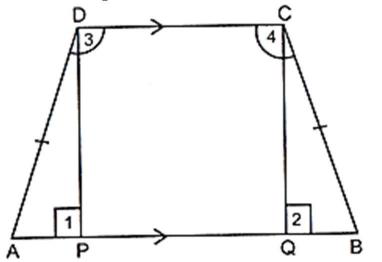
To prove: ∠A = ∠B and ∠C = ∠D.
Construction: Draw DP ⊥ AB and CQ ⊥ AB.
Proof: In ΔAPD and ΔBQC , we have
∠1 = ∠2 [∵Each equal to 90o]
AB = BC [Given]
[Distance between parallel line]
So, By RHS criterion of congruence, we have
ΔAPD ≅ ΔBQC [CPCT]
∴ ∠A = ∠B
Now, DC||AB
∠A + ∠3 = 180º …(1) [∵Sum of consecutive interior angles is 180o]
∠B + ∠4 = 180º …(2) [Same reason]
From (1) and (2), we get
∠A + ∠3 = ∠B + ∠4
⇒ ∠3 = ∠4 [∵∠A = ∠B]
⇒ ∠C = ∠D
Hence, proved.
Question. In Fig. 8.11, AB || DE, AB = DE, AC||DF and AC = DF. Prove that BC||EF and BC = EF.
Sol.

Given: AB||DE, AB = DE, AC||DF and AC = DF
To prove: BC||EF and BC = EF
Proof: AC||DF [Given]
And AC = DF [Given]
∴ ACFD is a parallelogram.
⇒ AD||CF …(1) [∵Opposite side of a ||gm are parallel]
And AD||CF …(2) [∵Opposite sides of a ||gm are equal]
Now, AB||DE [Given]
And AB = DE [Given]
∴ ABED is a parallelogram.
⇒ AD||BE …(3) [∵Opposite sides of a are||gm are parallel]
And AD = BE …(4) [∵ Opposite sides of a ||gm are equal]
From (1) and (3), we get
CF||BE
And, from (2) and (4) we get
CF||BE
∴ BDFE is a parallelogram.
⇒ BC||EF [∵Opposite sides of a ||gm are parallel]
And BC = EF [∵Opposite sides of a ||gm are equal]
Hence, proved.
Question. E is the mid-point of a median AD of ΔABC and BE is produced to meet AC at F. Show that AF = (1/2)AC
Sol. Given: A ΔABC in which E is the mid-point of median AB and BE is produced to meet AC at F.

To prove: AF = (1/2)AC
Construction: Draw DG||BF intersecting AC at G.
Proof: In ΔADG, E is the mid-point of AD and EF||DG.
∴ AF = FG …(1) [Converse of mid-point theorem]
In ΔFBC, D is the mid-point of BC and DG||BF.
∴ FG = GC …(2) [Converse of mid-point theorem]
From equation (1) and (2), we get
AF = FG = GC …(3)
But, AC = AF + FG + GC
⇒ AC = AF + AF + AF [Using (3)]
⇒ AC = 3AF
⇒ AF = (1/2)AC
Hence, proved.
Question. Show that the quadrilateral formed by joining the mid-points of the consecutive sides of a square is also a square.
Sol. Given: A square ABCD in which P, Q, R, S are the mid-points of sides AB, BC, CD, DA respectively. PQ, QR, RS and SP are joined.
To prove: PQRS is a square.
Construction: Join AC and BD.
Proof: In ΔABC , P and Q are the mid-points of sides AB and BC respectively.
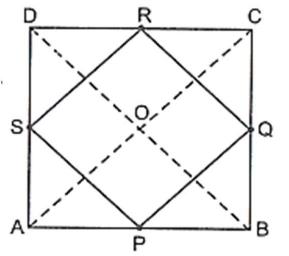
∴ PQ|| AC and
PQ = (1/2)AC …(1)
In DADC, R and S are the mid-points of CD and AD respectively.
∴ RS || AC and
RS = (1/2)AC …(2)
From eqs. (1) and (2), we get
PQ||RS and PQ = RS …(3)
Thus, in quadrilateral PQRS one pair of opposite sides are equal and parallel.
Hence, PQRS is a parallelogram.
Since ABCD is a square.
∴ AB = BC = CD = DA

⇒ PB = RC and BQ = CQ
Thus, in Δs PBQ and RCQ, we have
PB = RC
BQ = CQ [⇒ PB = CR and BQ = CQ]
And ∠PBQ = ∠RCQ [∵Each equal to 90o]
So, By SAS criterion of congruence, we have
ΔPBQ ≅ ΔRCQ
⇒ PQ = QR [CPCT] …(4)
From (3) and (4), we have
PQ = QR = RS
But, PQRS is a parallelogram
∴ PQ = PS
So, PQ = QR = RS = PS …(5)
Now, PQ||AC [From (1)]
⇒ PM||NO …(6)
Since, P and S are the mid-points of AB and AD respectively.
PS||BD
⇒ PN||MO …(7)
Thus, in quadrilateral PMON, we have
PM||NO [From (6)]
And PN||MO [From (7)]
So, PMON is a parallelogram.
⇒ ∠MPN = ∠MON
⇒ ∠MPN = ∠BOA [∵∠MPN = ∠BOA]
⇒ ∠MPN = 900
[∵ Diagonals of square are ∴ ⊥ AC ⊥ BD ⇒ ∠BOA = 900]
⇒ ∠QPS = 900
Thus, PQRS is a quadrilateral such that PQ = QR = RS = SP and ∠QPS = 900
Question. E and F are respectively the mid-points of the non-parallel sides AD and BC of a trapezium ABCD. Prove that EF || AB and 1/2 EF = (AB + CD) [Hint: Join BE and produce it to meet CD produced at G.]
Sol.

Given: A trapezium ABCD in which E and F are respectively the mid-points of the nonparallel sides AD and BC.
To prove: EF||AB and
EF = 1/2(AB +CD)
Construction: Join DF and produce it to intersect AB produced at G.
Proof: In ΔCFD and ΔBFG, we have
DC||AB
∴ ∠C = ∠3 [Alternate interior angles]
CF = BF
∠1 = ∠2 [Vertically opposite angles]
So, By ASA criterion of congruence, we have
DCFD ≅ DBFG
∴ CD = BG [CPCT]
EF joins mid-points of sides AD and GD respectively
∴ EF||AG [∵Mid-point theorem]
⇒ EF||AB
So, EF = (1/2) AG [Mid-point theorem]
⇒ EF = 1/2 (AB + AG)
⇒ EF = 1/2 (AB +CD) [∵CD = BG]
Hence, proved.
Question. Prove that the quadrilateral formed by the bisectors of the angles of a parallelogram is a rectangle.
Sol. Given: A quadrilateral ABCD in which bisectors of angles A, B, C, D intersect at P, Q, R, S to from a quadrilateral PQRS.
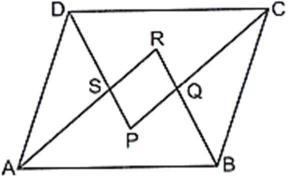
To Prove: PQRS is a rectangle.
Proof: Since ABCD is a parallelogram.
Therefore, AB||DC
Now, AB||DC and transversal AD intersect them at D and A respectively.
Therefore,
∠A+∠D =1800 [∵Sum of consecutive interior angles is 180o]
⇒ 1/2 ∠A = (1/2) ∠D =900
⇒ ∠DAS +∠ADS = 900 …(1)
[∵DS and AS are bisectors of ∠A and ∠D respectively]
But, in ΔDAS, we have
∠DAS +∠ASD+∠ADS =1800
[∵Sum of the angles of a triangle is 180o]
⇒∠900 +∠ASD =1800 [Using (1)]
⇒ ∠ASD = 900
⇒ ∠PSR = 900 [∵ ∠ASD and ∠PSR are vertically opposite angles
∴ ∠PSR = ∠ASD ]
Similarly, we can prove that
∠SRQ = 900 ,∠RQP = 900 and ∠SPQ = 900
Hence, PQRS is a rectangle.
Question. P and Q are points on opposite sides AD and BC of a parallelogram ABCD such that PQ passes through the point of intersection O of its diagonals AC and BD. Show that PQ is bisected at O.
Sol. ABCD is a parallelogram. Its diagonal AC and BD bisect each other at O. PQ passes through the point of intersection O of its diagonal AC and BD.

In ΔAOP and ΔCOQ, we have
∠3 = ∠4 [Alternate int. ∠s ]
OA = OC [Diagonals of a ||gm bisects each other]
∠1 = ∠2 [Vertically opposite angles]
∴ ΔAOP ≅ ΔCOQ [By ASA Congruence rule]
So, OP = OQ [CPCT]
Hence, PQ is bisected at O.
Question. ABCD is a rectangle in which diagonal BD bisects ∠B. Show that ABCD is a square.
Sol. Given: A rectangle ABCD in which diagonal BD bisects ∠B.
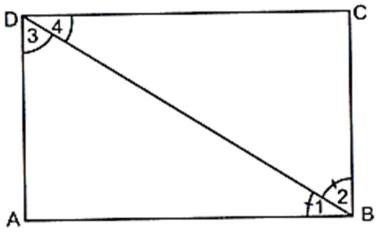
To prove: ABCD is a square.
Proof: DC||AB
[∵ Opposite sides of a rectangle are parallel]
⇒ ∠4 = ∠1 ..(1) [Alternate interior angles]
Similarly, ∠3 = ∠2 …(2) [Alternate interior angles]
And ∠1 = ∠2 …(3) [Given]
From equation (1), (2) and (3), we get
∠3 = ∠4
In ΔBDA and ΔBDC,we have
∠1 = ∠2 [Given]
BD = BD [Common side]
∠3 = ∠4 [proved above]
So, By ASA criterion of congruence, we have
ΔBDA ≡ ΔBDC
∴ AB = BC [CPCT]
So, ABCD is a square.
Hence, proved.
Question. D, E and F are respectively the mid-points of the sides AB, BC and CA of a triangle ABC. Prove that by joining these mid-points D, E and F, the triangles ABC is divided into four congruent triangles.
Sol. Given: A ΔABC and ΔDEF which is formed by joining the mid-point D, E and F of the sides AB, BC and CA of ΔABC.
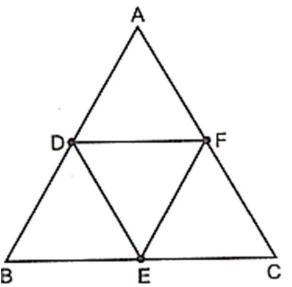
Mathematics Quadrilaterals Worksheets for Class 9 as per CBSE NCERT pattern
Parents and students are welcome to download as many worksheets as they want as we have provided all free. As you can see we have covered all topics which are there in your Class 9 Mathematics Quadrilaterals book designed as per CBSE, NCERT and KVS syllabus and examination pattern. These test papers have been used in various schools and have helped students to practice and improve their grades in school and have also helped them to appear in other school level exams. You can take printout of these chapter wise test sheets having questions relating to each topic and practice them daily so that you can thoroughly understand each concept and get better marks. As Mathematics Quadrilaterals for Class 9 is a very scoring subject, if you download and do these questions and answers on daily basis, this will help you to become master in this subject.
Benefits of Free Quadrilateral Worksheets geometry Class 9 Maths
- You can improve understanding of your concepts if you solve NCERT Class 9 Mathematics Quadrilaterals Worksheet,
- These CBSE Class 9 Mathematics Quadrilaterals worksheets can help you to understand the pattern of questions expected in Mathematics Quadrilaterals exams.
- All worksheets for Mathematics Quadrilaterals Class 9 for NCERT have been organized in a manner to allow easy download in PDF format
- Parents will be easily able to understand the worksheets and give them to kids to solve
- Will help you to quickly revise all chapters of Class 9 Mathematics Quadrilaterals textbook
- CBSE Class 9 Mathematics Quadrilaterals Workbook will surely help to improve knowledge of this subject
These Printable practice worksheets are available for free download for Class 9 Mathematics Quadrilaterals. As the teachers have done extensive research for all topics and have then made these worksheets for you so that you can use them for your benefit and have also provided to you for each chapter in your ebook. The Chapter wise question bank and revision worksheets can be accessed free and anywhere. Go ahead and click on the links above to download free CBSE Class 9 Mathematics Quadrilateral Worksheets PDF.

You can download free worksheets for Class 9 Mathematics Quadrilaterals from https://www.worksheetsbag.com
You can get free PDF downloadable worksheets for Grade 9 Mathematics Quadrilaterals from our website which has been developed by teachers after doing extensive research in each topic.
On our website we have provided worksheets for all subjects in Grade 9, all topic wise test sheets have been provided in a logical manner so that you can scroll through the topics and download the worksheet that you want.
You can easily get question banks, topic wise notes and questions and other useful study material from https://www.worksheetsbag.com without any charge
Yes all test papers for Mathematics Quadrilaterals Class 9 are available for free, no charge has been put so that the students can benefit from it. And offcourse all is available for download in PDF format and with a single click you can download all worksheets.
https://www.worksheetsbag.com is the best portal to download all worksheets for all classes without any charges.